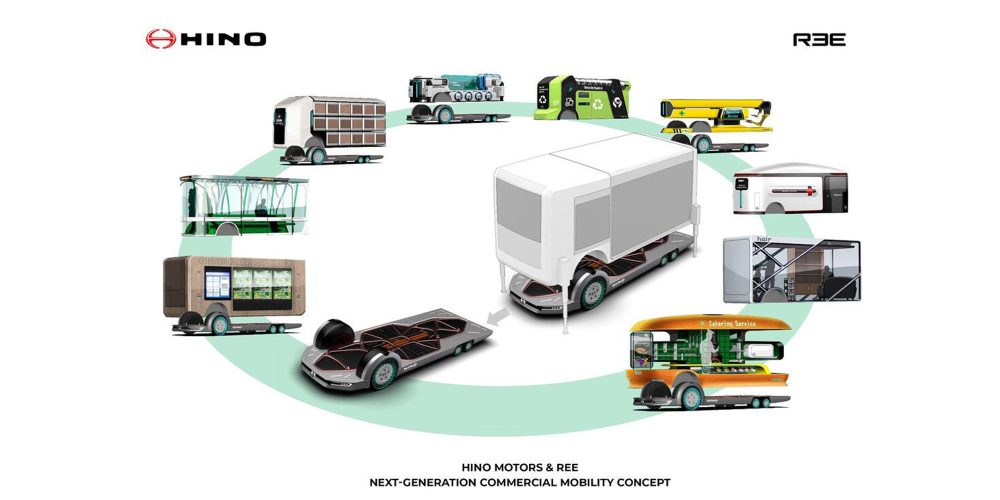
REE Automotive and Hino Motors, a subsidiary of Toyota Motor Group, announced a business alliance to design and produce solutions in “next-generation commercial mobility.” The alliance will combine Hino’s experience as a commercial vehicle manufacturer with REE’s proprietary REEcorner technologies. The result should be a unique modular platform capable of serving a multitude of various purposes.
REE Automotive is an EV startup headquartered in Tel Aviv, with subsidiaries in the US, UK, and Germany. It specializes in developing and manufacturing REEcorners and modular EV platforms for B2B transactions. According to its website, REE has a unique CapEx-light manufacturing model that leverages its Tier 1 partners’ existing production lines.
Earlier this year, REE announced a SPAC merger with 10X Capital Venture Acquisition Corp. ($VCVC) generating $500 million in gross proceeds. Next, the company announced a “strategic collaboration” with Magna International, which will allow both companies to explore the possibilities of fully modular electric vehicles (MEVs) and bring them to market donning a “Powered by REE” brand.
According to today’s press release, REE Automotive’s latest collaboration is with Hino Motors, a Toyota Group subsidiary selling trucks and buses in more than 80 countries. This “business alliance” between both parties solidifies a long-term partnership that began in 2019 when the two developed its FlatFormer concept. The goal of the agreement announced today is to commercialize the FlatFormer platform from concept to full production.

REE Automotive x Toyota’s Hino Motors
The first electric mobility solution to emerge from this alliance is the FlatFormer concept originally introduced at 2019’s Tokyo Motor Show. It’s comprised of REE’s proprietary modular platform and designed to carry a customizable Mobility Service Module on top. This Module can carry anything from passengers, deliveries, goods, or operate as a business on wheels.
Furthermore, the Mobility Service Module can be detached from the EV platform and sit as a standalone unit. This would in turn allow the original platform to operate separately and continue to serve a new purpose. Daniel Barel, cofounder and CEO of REE said:
The FlatFormer unveiling at the 2019 Tokyo Motor Show proved to be a turning point in future electric mobility and set the stage for this exciting alliance with the visionary team at Hino. We see this alliance as a unique opportunity to fulfill our shared mission of improving quality of life for people around the world by developing and bringing to market revolutionary next-generation EVs.
The FlatFormer solution has potential to offer unique Mobility as a Service (MaaS) solutions as well as other helpful implementations for customers. Its low floor and fully flat design around REE’s modular platform offers expandability to fit the need of the customer. It also supports the technology for autonomous driving. REE’s technology, along with the support of an OEM like Toyota through Hino, certainly helps too.
The next goal of the automakers is to develop hardware prototypes by the fiscal year 2022. At the same time, REE and Hino Motors will evaluate business models, seek further engagement from potential customers, and conduct demonstrations of its developing technology.
Electrek’s Take
The future is modular. We’ve covered REE Automotive before, due to its unique and innovative platforms and proprietary REEcorners. Its recent partnership with Magna was a huge step in applying its tech with the know-how and manufacturing infrastructure needed to find successful scalability.
Now in working with Hino, its B2B strategy gels well with the Japanese company’s experience in commercial trucks and buses. REE also gains another major OEM in Toyota by having this new alliance with Hino Motors. While the FlatFormer (solid name) remains a concept, it has some big upside in potential looking toward the future of electric mobility.
The focus on modularity and mobility as a service could prove successful, if these companies can get a vehicle to market. It reminds us a bit of Canoo’s MPDV, in which its completely customizable top half can fit nearly any job and/or purpose. REE and Hino have taken things a step further by allowing this Mobility Service Module to live separately from its platform, thus creating a standalone structure or business.
Furthermore, it allows the platform to be reused by either adding a new MSM on top or repurposing it for a new task. We’ll have to keep eyes on the progress of this one.
Subscribe to Electrek on YouTube for exclusive videos and subscribe to the podcast.
Author: Scooter Doll
Source: Electrek



